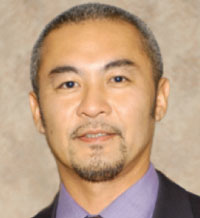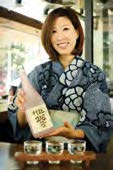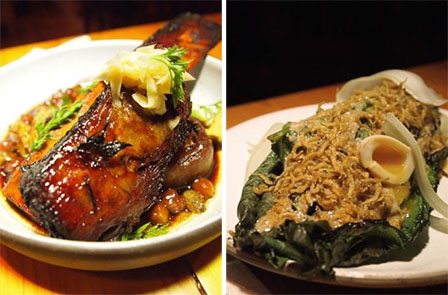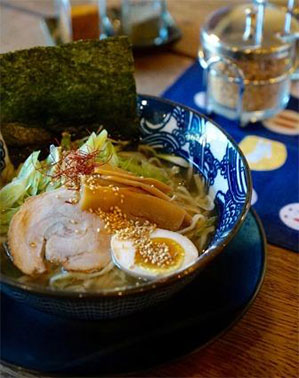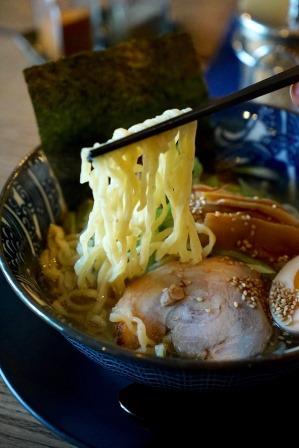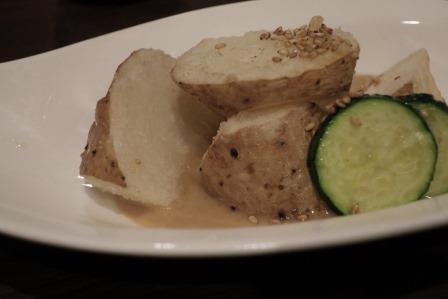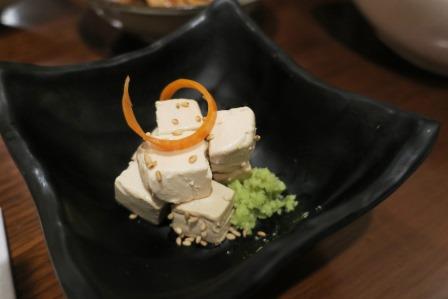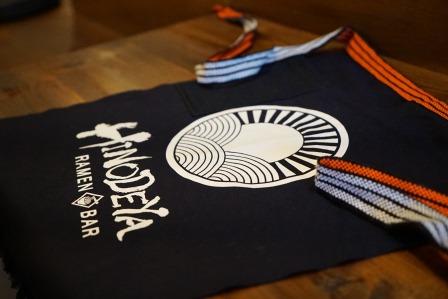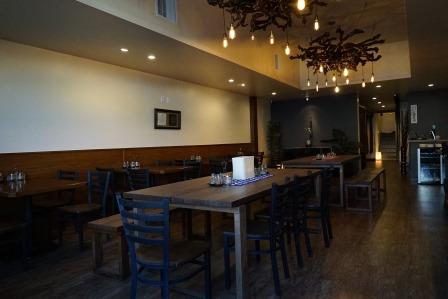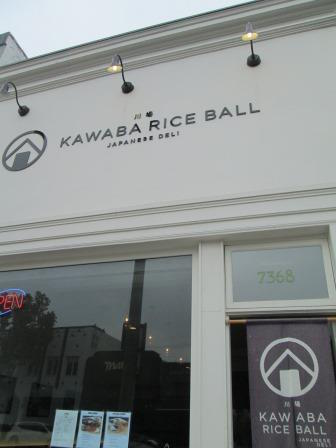Orthodox okonomiyaki arrives in South Bay
By Elli Sekine
They say that there are about 1,000 Japanese restaurants in the bay area. It seems very likely, but didn’t really exist was okonomiyaki restaurants.
Okonomiyaki is one of the top Japanese foods which had been considered by the local Japanese and American okonomiyaki fans for a long time as “a Japanese food hoped to exist locally”. And, finally, by a man who had been longing for a delicious okonomiyaki restaurant, the very first okonomiyaki specialty restaurant, “FUGETSU” opened in South Bay.
The idea came from Yasumitsu Yamamoto from Osaka, and Shinya Fujimoto, the restaurant manager. They kicked off an American company, “FUGETSU U.S.A.” in corporation with Takanori Itsukage, CEO, IDEA Co Ltd. Mr. Yamamoto is a veteran restaurateur who runs seven Japanese restaurants around South Bay area. On the other hand, Mr. Fujimoto who manages the restaurant has been residing in the U.S for 20 years, but used to work in the IT industry in Silicon Valley for a long time, and quit from the salary man life to run a restaurant for the first time. What triggered the idea of opening an okonomiyaki restaurant was “Tsuruhashi-FUGETSU” of Osaka which Mr. Fujimoto was a long-time fan of, and used to visit every time he went back to Japan on a business or a private trip. His wish to have such a delicious okonomiyaki place in the bay area gradually grew bigger and bigger.
A while after befriended with Mr. Itsukage of IDEA Co., Mr. Fujimoto proposed a business plan. Everyone from Osaka here in the States may think somewhat the same way, but I take my hat off to Mr. Fujimoto’s ability to take action. The “FUGETSU” chain has about 80 restaurants throughout Japan, but only 5 in Asia as overseas development. “If they can make it in Asia, they should be able to make it in America also.” So convinced, Mr. Fujimoto did all thinkable preparations and trial and error, and finally opened the door of “FUGETSU U.S.A” in the Silicon Valley last November.
In the poor period of Japan after the war, okonomiyaki spread as a street food using cheap ingredients that were attainable at the time. Now, it is a soul food eaten daily, and loved by all from children to elderlies. Okonomiyaki literally means to cook whatever you like on the iron plate. Its cooking style differs from region to region, but there are two main streams; Hiroshima, and Osaka styles. In Hiroshima style, the base dough is poured first on the iron plate like making a crepe, and then other ingredients such as cabbage, noodles, etc. are piled on top of the crepe. On the other hand, in Osaka style, the dough and the ingredients are mixed together before cooked. Osaka where okonomiyaki is eaten the most often, The “FUGETSU” chain is extremely popular. It was born in the 1950s in the barracks of Tsuruhashi which is known as a blue-collar workers town. According to the old couple who used to run the original place there, “the taste of grandma” was carried over in 1989 by Mr. Takanori Itsukage. Since then, the place which used to be only one there expanded to a nationwide scale, and its overseas development is being accelerated.
In fact, a Hiroshima style okonomiyaki restaurant once opened in the bay area more than 10 years ago, but went out of business within a year. As a matter of fact, it is not as easy as you think to make good okonomiyaki. It takes unlikely amount of ingenuity and technique to make a perfect fluffy and delicious okonomiyaki. At “FUGETSU”, special okonomiyaki cooker staff is always there to cook for you, so you can always have high-quality FUGETSU brand okonomiyaki pancakes cooked with the original technique. They are crispy outside and fluffy inside, which is the ultimate Kansai style. The cabbage, the core ingredient, is procured from the contracted farms, and is cut with a watermelon knife to preserve its fibers to retain the volume and the sweetness. The flour for the flavorful dough is made in Japan. The egg noodles for the yakisoba which is made just for them, is boiled carefully for the right amount of time, and comes out as chewy and textured noodles to accentuate the okonomiyaki. Based on those basic ingredients, your favorite ingredients such as pork, seafood etc., are added, Japan-made flavorful shaved bonito tops it as the last ingredient before cooked to perfection on a thick iron plate. To finish, the home-made secret sauce (unchanged from the beginning), and mayonnaise decorate to complete a tasty “FUGETSU” okonomiyaki. The signature menu items are “Pork Modan”, “Squid Modan”, and “FUGETSU-Yaki” which has many ingredients including squid, shrimp, pork, and beef. The word Modan means that the okonomiyaki is layered with Yakisoba. For dinner time, other a-la-carte menu items can be ordered as well. As a drink for pairing, I recommend Asahi draft beer directly imported from Japan. This authentic Osaka style okonomiyaki restaurant has been very busy ever since the opening, and the wait can be as long as one hour.
Lately, I occasionally come across the word “Okonimiyaki” in Korean restaurants and on food trucks. I hope okonomiyaki, which has not yet been known very much in the United States, will become the next boom because of this emerge of “Tsuruhashi FUGETSU” from Osaka, the home of okonomiyaki.
大阪の本格派お好み焼き店がサウスベイにオープン!
ベイエリアには毎年新しい日本食レストランが増え続けているが、日本食レストランは約1000軒あると言われているが、今までありそうでなかったのが、お好み焼き専門店だ。地元在住の日本人やお好み焼きファンのアメリカ人の間では「あれば良い日本食」として長年上位に上がっていた。そして、その美味しいお好み焼き店の存在を切望していた1人の男により、この度ついにベイエリアでお好み焼き専門店一号店となる「FUGETSU」がサウスベイにオープンした。
仕掛け人は、大阪出身の山本泰光氏と店舗責任者の藤本真也氏。両氏は株式会社イデア(五影隆則現代表取締)と合弁で米国法人「FUGETSU U.S.A.」 を立ち上げた。山本氏はサウスベイを中心に7店舗の日本食店をベテラン経営者。一方、同店の責任者を務める藤本氏は、在米歴20年。長年勤めていたシリコンバレーのIT企業 から脱サラをし、今回初めてのレストラン経営者となる。オープンのきっかけは、藤本氏が出張や帰省の度に通っていた大阪の「鶴橋風月」のファンだった事から。次第にこのような美味しいお好み焼き店がベイエリアにあれば良いという強い想いを募らせた。やがて五影氏と交流をするようになったある日、藤本氏からビジネスプランを提案したという。大阪出身の在米者なら誰もが願う事だが、彼の実行力には脱帽だ。「風月」は現在、日本全国に約80店舗を数えるが、海外ではまだアジア地区に5店舗のみ。「アジアに進出できたなら米国でもできるはず」と確信を抱いた同氏は、あらゆる下準備と試行錯誤を重ね、ついに去年11月末、シリコンバレーに「FUGETSU U.S.A.」のドアを開いた。
お好み焼きは、戦後貧しい日本で調達できた安い食材を使った屋台フードとして広がった。今では子供からお年寄りまで日常食べられているソウルフードだ。「お好み焼き」とは文字通り、「お好み」具材を鉄板で焼くと言う意味。地方でその焼き方に特徴があるが、大きく分ければ広島焼きと大阪焼き。広島風はまず生地をクレープ状に引き、その上に重ねるようにキャベツや焼きそば、具を載せていく。一方、大阪風は、生地と食材を練りこんで焼く方法。日本で最もお好み焼きが食べられている大阪で絶大な人気を誇る「風月」は、1950年代、労働階級の町として知られる鶴橋のバラックから生まれた。当時経営していた老夫婦による「おばあちゃんの味」は1989年、五影隆則氏により継承された。それ以来、たった一軒だった店は現在、全国展開し、さらに海外進出も加速している。
実はベイエリアには10数年前に広島風お好み焼き店がオープンしている。しかし一年を待たずに閉店した。結局のところ、さほど難しくないと思われがちなお好み焼きは、ふっくら美味しく仕上げるには至難の工夫と技を必要とする。「FUGETSU] では、お好みを焼く専門スタッフが常駐し、オリジナルの手法で、「風月」ブランドそのままのクオリティー高いお好み焼きが食べられる。外はパリパリ、中はふっくり焼きあげるのは関西風の極みだ。要となるキャベツは、特定の農家から仕入れ、スイカ包丁で繊維を残しながら切り、質感と甘みを引き立て、生地となる小麦粉は風味のある日本国産、焼きそばになるたまご麺は独自で作り茹で時間も微調整し、もっちり歯ごたえがある麺がアクセントになる。これらの材料を元に豚やシーフードなど「お好み」の具材を混ぜ、最後に日本国産の香りの良い鰹節を投入し、厚い鉄板でじっくり焼き上げる。仕上げは秘伝の自家製ソース(開店当初から変わらない)とマヨネーズで香ばしい「風月」のお好み焼きは完成する。看板メニューは、「豚玉モダン」、「いか玉モダン」、いか、えび、ぶた、牛肉の具材たっぷりの「風月焼」など。モダンとは焼きそばが入る重ねやき。ディナーメニューにはさらに一品メニューが揃う。相性が良いドリンクとして日本輸入のアサヒドラフトビールがオススメだ。この本格的大阪風のお好み焼き店、すでに開店当初から1時間以上の列ができるほど繁栄している。
最近、韓国レストランやフードトラック「Okonomiyaki」の文字が見られるようになってきた。今まであまりアメリカで知られていなかったお好み焼きは、この本場大阪からの「鶴橋風月」の出現により次なるブームになることを期待している。
FUGETSU
2783 El Camino Real, Santa Clara, CA 95051
(408) 244-8500
http://www.fugetsu-usa.com/en/
Open every day : 11:30AM–2PM, 6–10PM
They say that there are about 1,000 Japanese restaurants in the bay area. It seems very likely, but didn’t really exist was okonomiyaki restaurants.
Okonomiyaki is one of the top Japanese foods which had been considered by the local Japanese and American okonomiyaki fans for a long time as “a Japanese food hoped to exist locally”. And, finally, by a man who had been longing for a delicious okonomiyaki restaurant, the very first okonomiyaki specialty restaurant, “FUGETSU” opened in South Bay.
The idea came from Yasumitsu Yamamoto from Osaka, and Shinya Fujimoto, the restaurant manager. They kicked off an American company, “FUGETSU U.S.A.” in corporation with Takanori Itsukage, CEO, IDEA Co Ltd. Mr. Yamamoto is a veteran restaurateur who runs seven Japanese restaurants around South Bay area. On the other hand, Mr. Fujimoto who manages the restaurant has been residing in the U.S for 20 years, but used to work in the IT industry in Silicon Valley for a long time, and quit from the salary man life to run a restaurant for the first time. What triggered the idea of opening an okonomiyaki restaurant was “Tsuruhashi-FUGETSU” of Osaka which Mr. Fujimoto was a long-time fan of, and used to visit every time he went back to Japan on a business or a private trip. His wish to have such a delicious okonomiyaki place in the bay area gradually grew bigger and bigger.
A while after befriended with Mr. Itsukage of IDEA Co., Mr. Fujimoto proposed a business plan. Everyone from Osaka here in the States may think somewhat the same way, but I take my hat off to Mr. Fujimoto’s ability to take action. The “FUGETSU” chain has about 80 restaurants throughout Japan, but only 5 in Asia as overseas development. “If they can make it in Asia, they should be able to make it in America also.” So convinced, Mr. Fujimoto did all thinkable preparations and trial and error, and finally opened the door of “FUGETSU U.S.A” in the Silicon Valley last November.
In the poor period of Japan after the war, okonomiyaki spread as a street food using cheap ingredients that were attainable at the time. Now, it is a soul food eaten daily, and loved by all from children to elderlies. Okonomiyaki literally means to cook whatever you like on the iron plate. Its cooking style differs from region to region, but there are two main streams; Hiroshima, and Osaka styles. In Hiroshima style, the base dough is poured first on the iron plate like making a crepe, and then other ingredients such as cabbage, noodles, etc. are piled on top of the crepe. On the other hand, in Osaka style, the dough and the ingredients are mixed together before cooked. Osaka where okonomiyaki is eaten the most often, The “FUGETSU” chain is extremely popular. It was born in the 1950s in the barracks of Tsuruhashi which is known as a blue-collar workers town. According to the old couple who used to run the original place there, “the taste of grandma” was carried over in 1989 by Mr. Takanori Itsukage. Since then, the place which used to be only one there expanded to a nationwide scale, and its overseas development is being accelerated.
In fact, a Hiroshima style okonomiyaki restaurant once opened in the bay area more than 10 years ago, but went out of business within a year. As a matter of fact, it is not as easy as you think to make good okonomiyaki. It takes unlikely amount of ingenuity and technique to make a perfect fluffy and delicious okonomiyaki. At “FUGETSU”, special okonomiyaki cooker staff is always there to cook for you, so you can always have high-quality FUGETSU brand okonomiyaki pancakes cooked with the original technique. They are crispy outside and fluffy inside, which is the ultimate Kansai style. The cabbage, the core ingredient, is procured from the contracted farms, and is cut with a watermelon knife to preserve its fibers to retain the volume and the sweetness. The flour for the flavorful dough is made in Japan. The egg noodles for the yakisoba which is made just for them, is boiled carefully for the right amount of time, and comes out as chewy and textured noodles to accentuate the okonomiyaki. Based on those basic ingredients, your favorite ingredients such as pork, seafood etc., are added, Japan-made flavorful shaved bonito tops it as the last ingredient before cooked to perfection on a thick iron plate. To finish, the home-made secret sauce (unchanged from the beginning), and mayonnaise decorate to complete a tasty “FUGETSU” okonomiyaki. The signature menu items are “Pork Modan”, “Squid Modan”, and “FUGETSU-Yaki” which has many ingredients including squid, shrimp, pork, and beef. The word Modan means that the okonomiyaki is layered with Yakisoba. For dinner time, other a-la-carte menu items can be ordered as well. As a drink for pairing, I recommend Asahi draft beer directly imported from Japan. This authentic Osaka style okonomiyaki restaurant has been very busy ever since the opening, and the wait can be as long as one hour.
Lately, I occasionally come across the word “Okonimiyaki” in Korean restaurants and on food trucks. I hope okonomiyaki, which has not yet been known very much in the United States, will become the next boom because of this emerge of “Tsuruhashi FUGETSU” from Osaka, the home of okonomiyaki.
大阪の本格派お好み焼き店がサウスベイにオープン!
ベイエリアには毎年新しい日本食レストランが増え続けているが、日本食レストランは約1000軒あると言われているが、今までありそうでなかったのが、お好み焼き専門店だ。地元在住の日本人やお好み焼きファンのアメリカ人の間では「あれば良い日本食」として長年上位に上がっていた。そして、その美味しいお好み焼き店の存在を切望していた1人の男により、この度ついにベイエリアでお好み焼き専門店一号店となる「FUGETSU」がサウスベイにオープンした。
仕掛け人は、大阪出身の山本泰光氏と店舗責任者の藤本真也氏。両氏は株式会社イデア(五影隆則現代表取締)と合弁で米国法人「FUGETSU U.S.A.」 を立ち上げた。山本氏はサウスベイを中心に7店舗の日本食店をベテラン経営者。一方、同店の責任者を務める藤本氏は、在米歴20年。長年勤めていたシリコンバレーのIT企業 から脱サラをし、今回初めてのレストラン経営者となる。オープンのきっかけは、藤本氏が出張や帰省の度に通っていた大阪の「鶴橋風月」のファンだった事から。次第にこのような美味しいお好み焼き店がベイエリアにあれば良いという強い想いを募らせた。やがて五影氏と交流をするようになったある日、藤本氏からビジネスプランを提案したという。大阪出身の在米者なら誰もが願う事だが、彼の実行力には脱帽だ。「風月」は現在、日本全国に約80店舗を数えるが、海外ではまだアジア地区に5店舗のみ。「アジアに進出できたなら米国でもできるはず」と確信を抱いた同氏は、あらゆる下準備と試行錯誤を重ね、ついに去年11月末、シリコンバレーに「FUGETSU U.S.A.」のドアを開いた。
お好み焼きは、戦後貧しい日本で調達できた安い食材を使った屋台フードとして広がった。今では子供からお年寄りまで日常食べられているソウルフードだ。「お好み焼き」とは文字通り、「お好み」具材を鉄板で焼くと言う意味。地方でその焼き方に特徴があるが、大きく分ければ広島焼きと大阪焼き。広島風はまず生地をクレープ状に引き、その上に重ねるようにキャベツや焼きそば、具を載せていく。一方、大阪風は、生地と食材を練りこんで焼く方法。日本で最もお好み焼きが食べられている大阪で絶大な人気を誇る「風月」は、1950年代、労働階級の町として知られる鶴橋のバラックから生まれた。当時経営していた老夫婦による「おばあちゃんの味」は1989年、五影隆則氏により継承された。それ以来、たった一軒だった店は現在、全国展開し、さらに海外進出も加速している。
実はベイエリアには10数年前に広島風お好み焼き店がオープンしている。しかし一年を待たずに閉店した。結局のところ、さほど難しくないと思われがちなお好み焼きは、ふっくら美味しく仕上げるには至難の工夫と技を必要とする。「FUGETSU] では、お好みを焼く専門スタッフが常駐し、オリジナルの手法で、「風月」ブランドそのままのクオリティー高いお好み焼きが食べられる。外はパリパリ、中はふっくり焼きあげるのは関西風の極みだ。要となるキャベツは、特定の農家から仕入れ、スイカ包丁で繊維を残しながら切り、質感と甘みを引き立て、生地となる小麦粉は風味のある日本国産、焼きそばになるたまご麺は独自で作り茹で時間も微調整し、もっちり歯ごたえがある麺がアクセントになる。これらの材料を元に豚やシーフードなど「お好み」の具材を混ぜ、最後に日本国産の香りの良い鰹節を投入し、厚い鉄板でじっくり焼き上げる。仕上げは秘伝の自家製ソース(開店当初から変わらない)とマヨネーズで香ばしい「風月」のお好み焼きは完成する。看板メニューは、「豚玉モダン」、「いか玉モダン」、いか、えび、ぶた、牛肉の具材たっぷりの「風月焼」など。モダンとは焼きそばが入る重ねやき。ディナーメニューにはさらに一品メニューが揃う。相性が良いドリンクとして日本輸入のアサヒドラフトビールがオススメだ。この本格的大阪風のお好み焼き店、すでに開店当初から1時間以上の列ができるほど繁栄している。
最近、韓国レストランやフードトラック「Okonomiyaki」の文字が見られるようになってきた。今まであまりアメリカで知られていなかったお好み焼きは、この本場大阪からの「鶴橋風月」の出現により次なるブームになることを期待している。
FUGETSU
2783 El Camino Real, Santa Clara, CA 95051
(408) 244-8500
http://www.fugetsu-usa.com/en/
Open every day : 11:30AM–2PM, 6–10PM

